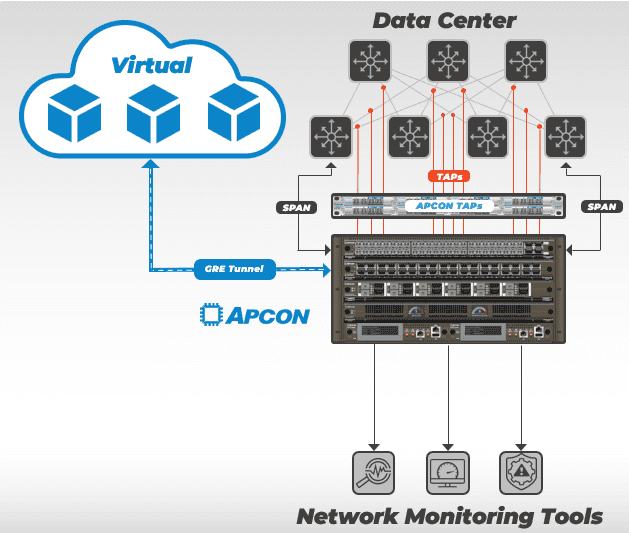- Published on
Bring Public Cloud Computing Back Home with APCON’s IntellaTap-VM
- Updated on

Over the last several years, Reverse Cloud Migration, also known as cloud repatriation, has grown into a full-blown IT phenomenon. The term refers to the movement of data, applications, or workloads from a public cloud environment back to an on-premises infrastructure. Cost considerations, data sovereignty issues, performance optimization, legal compliance, and evolving business requirements are just a few of the factors driving the popularity of this trend.
- Cost Considerations: The pay-as-you-go architecture and scalability of the cloud initially drew many enterprises to shift to it. But as use increased, businesses found themselves facing unforeseen high expenses, particularly for data transfer or long-term storage.1 Relocating back onsite can help reduce variable costs related to cloud services and provide more predictable cost structures.
- Data Sovereignty and Compliance: Strict laws governing data residency and compliance apply to specific sectors of the economy or geographical areas. Shifting data back on-premise guarantees better control over its location and compliance with legal obligations.
- Performance Optimization: On-premises infrastructures can frequently offer better performance and lower latency than accessing resources via the Internet from a public cloud provider, especially for applications with high performance requirements or workloads sensitive to slower transactions or customer service delays.
- Security Concerns: While cloud providers offer robust security measures, some organizations are still very wary about trusting specific security requirements or extremely sensitive data to third-party providers. Returning data to in-house systems allows for tighter control and customization of security measures.
- Changing Business Needs: As businesses evolve, their IT requirements may change. Certain workloads could be more appropriate for an on-premises infrastructure because of certain organizational strategy changes or operational requirements.
In the burgeoning trend of repopulating on-premises networks, virtual machines (VMs) play a crucial role in processing data — replacing the workloads performed in a public cloud — by providing a flexible and scalable computing environment. Here are five ways that data centers looking to bring cloud tasks in-house might benefit from virtual machines.
- Resource Consolidation: VMs allow consolidation of multiple workloads onto a single physical server, optimizing resource utilization and reducing hardware costs.
- Flexibility and Scalability: VMs can be easily provisioned, scaled up or down, and migrated across different physical servers within the on-premises infrastructure, providing flexibility to adapt to changing workload demands.
- Isolation and Security: VMs provide isolation between different applications or workloads running on the same physical hardware, enhancing security and minimizing the risk of resource contention or performance degradation.
- Portability: Workloads can be seamlessly moved between on-premises infrastructures and public cloud providers when necessary, since virtual machines are portable across various virtualization technologies and settings.
- Management and Automation: VM management tools and automation technologies streamline the deployment, configuration, monitoring, and maintenance of VMs, reducing administrative overhead and improving operational efficiency.
APCON is a leading provider of hardware and software solutions for data monitoring. Its network-tested IntellaTap-VM software, included with the deployment of APCON’s IntellaView Enterprise switch management software, is an agnostic VM solution (can receive data in multiple formats from multiple sources) to help IT teams with East-West VM data monitoring required for successful Reverse Cloud Migrations (see diagram below for a simple illustration).

The APCON solution offers several features to enable simplified virtual monitoring.
-
IntellaTap-VM unifies virtual and physical monitoring in a single, simple, and efficient user interface that is scalable to global coverage.
-
Using IntellaTap-VM, data centers get fast access to long-term strategic and tactical virtual data.
- Perform speedy, ad-hoc troubleshooting of virtual environments.
- Easily tune and adjust static or complex long-term data collection needs in virtual environments.
- Automated deployment allows for current and future migration and environment changes.
-
Configure and connect IntellaTap-VM servers managed by IntellaView Enterprise, including tunnels & filters.
-
Add servers and group them for ease of managing traffic and connections. IntellaTap-VM allows the grouping of VM agents. A new configuration wizard streamlines the management of agent connections.
-
Filter network streams for data of interest and efficiently find what you need — and find it fast.
-
IntellaTap-VM provides the health and status of your virtual monitoring agents, tunnels, and traffic.
-
Get granular control over users and set up their specific access authorizations.
-
Send traffic to any performance, analysis, and security appliance.
- Deliver traffic to virtual tools within the virtual environment.
- Send traffic from the virtual environment to a core or more robust toolset.
-
APCON’s integration with the NSX Manager API provides these useful options:
- Select multiple segments for VM monitoring.
- Mirror and filter the traffic from those segments.
- Tunnel the traffic to APCON IntellaView series switches.
-
In addition to NSX Manager, IntellaTap-VM is compatible with Cisco, vCenter, and other solutions.
Avoid Blind Spots
As more networks return cloud data to virtualized in-house networks, a visibility gap occurs. A significant amount of East-West traffic (or traffic between VMs) never actually leaves the virtual environment and, more importantly, never traverses through the physical network where traditional monitoring technologies are deployed. Organizations without the capability to monitor virtual network traffic leave themselves open to significant security vulnerabilities and technical issues.
IntellaTap-VM provides magnified visibility of virtual network traffic. This is done by applying virtual traffic capture points in the virtual network that allow you to quickly and easily identify areas within your environment for 24x7x365 monitoring. The traffic of interest can be further processed for your security/performance tools, allowing them to function at top efficiency.
When moving workloads, data, and apps from the public cloud back to an on-premises infrastructure, your Reverse Cloud Migration is underway. On-premises data processing gets strong support from the flexibility, scalability, isolation, security, and management features that virtual machines managed by APCON's IntellaTap-VM can provide. For a deeper dive into IntellaTap-VM concepts, contact our APCON team.
1 https://www.techtarget.com/searchcio/news/366570542/Cloud-costs-continue-to-rise-in-2024